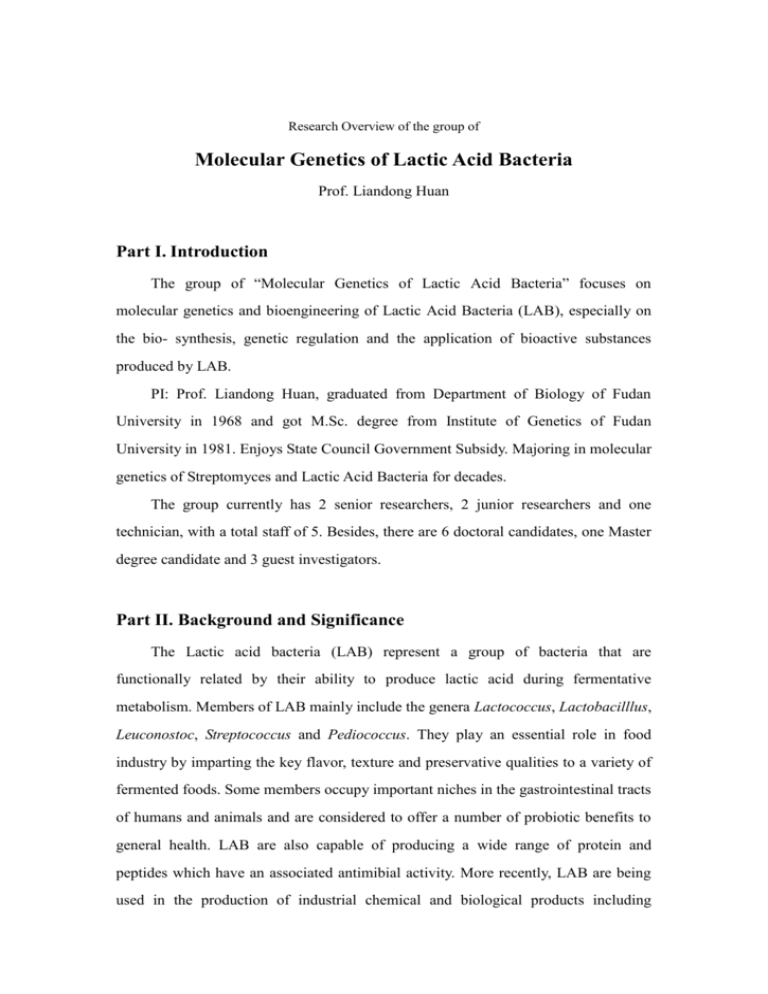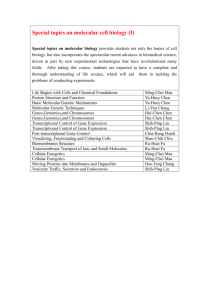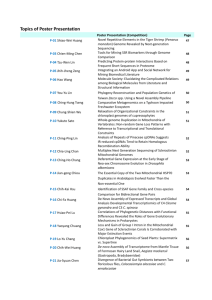HUAN Liandong
advertisement

Research Overview of the group of Molecular Genetics of Lactic Acid Bacteria Prof. Liandong Huan Part I. Introduction The group of “Molecular Genetics of Lactic Acid Bacteria” focuses on molecular genetics and bioengineering of Lactic Acid Bacteria (LAB), especially on the bio- synthesis, genetic regulation and the application of bioactive substances produced by LAB. PI: Prof. Liandong Huan, graduated from Department of Biology of Fudan University in 1968 and got M.Sc. degree from Institute of Genetics of Fudan University in 1981. Enjoys State Council Government Subsidy. Majoring in molecular genetics of Streptomyces and Lactic Acid Bacteria for decades. The group currently has 2 senior researchers, 2 junior researchers and one technician, with a total staff of 5. Besides, there are 6 doctoral candidates, one Master degree candidate and 3 guest investigators. Part II. Background and Significance The Lactic acid bacteria (LAB) represent a group of bacteria that are functionally related by their ability to produce lactic acid during fermentative metabolism. Members of LAB mainly include the genera Lactococcus, Lactobacilllus, Leuconostoc, Streptococcus and Pediococcus. They play an essential role in food industry by imparting the key flavor, texture and preservative qualities to a variety of fermented foods. Some members occupy important niches in the gastrointestinal tracts of humans and animals and are considered to offer a number of probiotic benefits to general health. LAB are also capable of producing a wide range of protein and peptides which have an associated antimibial activity. More recently, LAB are being used in the production of industrial chemical and biological products including biopolymers, bulk enzymes, ethanol, lactic acid and antimicrobials. The LAB are also strong candidates for development as oral delivery vehicles for digestive enzymes and vaccine antigens. Their innate acid tolerance, ability to survive gastric passage, and safety record during human consumption, are key features that can be exploited to effectively deliver biologics to targeted locations and tissues. Realizing their practical significance in fermentation, bioprocessing, agriculture, food and medicine, the LAB have been the subject of considerable research and commercial development over the past decade. Our research concentrates on molecular genetics and bioengineering of LAB and bioactive substances produced by LAB, including the construction of food-grade gene expression system and the development of technological platform to produce interested protein in LAB; isolation and characterization of bioactive substances from LAB (and other bacteria), cloning the complete gene cluster and exploring the mechanism of the biosynthesis, genetic regulation, gene expression, and structurefunction relationship of them; large-scale production of bioactive substances and their application and exploitation. Part III. Major Achievements Major achievements made during Innovation Phase II can be highlighted as follows: 1. Research on bioactive substances: 1) NisinZ: a) A L.lactis strain with high nisinZ productivity was got by selecting and inducing from milk samples; Technology of fermentation and extraction was improved; Large-scale production (150t/year) of nisinZ was succeed and the product was already used in food area domestic and abroad. b) Gene library was established and the complete nisinZ biosynthesis gene cluster was cloned; Promoter of nisinZ and nisin resistant gene were also cloned, and their functions were studied respectively. c) Structure-function relationship of hinge region of nisinZ molecule was studied by performing site-directed mutagenesis and mutants with wider antimicrobial spectrum or higher solubility were obtained. 2) Bovicin HJ50: A bacteriocin (Bovicin HJ50)-producing strain was isolated from raw milk, and the biochemical and genetic characterization of the novel lantibiotic bovicin HJ50 produced by Streptococcus bovis HJ50 was studied. The whole gene cluster involved in bovicin HJ50 biosynthesis was got (about 15kb), which including structural, modification, processing, transport, immunity, regulatory and associated genes. 3) Subpeptin JM4-A and Subpeptin JM4-B: An antimicrobial peptide producer strain was isolated from soil and purification and characterization of two novel antimicrobial peptides Subpeptin JM4-A and Subpeptin JM4-B produced by Bacillus subtilis JM4 were carried out. They had a relatively broad inhibitory spectrum and were very stable. Primary studies (gene disruption) showed that the 1.4kDa Subpeptin JM4-A and JM4-B were nonribosomally synthesized. 4) AP311: The heat stable antimicrobial peptide (AP311) produced by Lactobacillus acidophilus was isolated and its property was studied. 5) Nattokinase: A nattokinase producer strain was isolated from Chinese traditional food natto and identified as Bacillus subtilis YF38. The newly cloned fibrinolytic enzyme gene was secretorily expressed in E. coli. Structure-function relationship of active and binding region of nattokinase gene was studied by performing site-directed mutagenesis, and mutants with different activities were obtained. 2. Research on food-grade gene expression system in LAB: 1) Construction of food-grade gene expression system: Different elements for food-grade gene expression including nisZ promoter as inducible promoter, nisin resistance gene (nsr) as selection marker, and signal peptide sequence (SlpA) etc. were cloned, in addition to other constitutive promoters like P59 and P32, signal peptide sequence like Usp45, cell wall anchoring sequence like sac and M6 etc., a series of vectors suitable for different expressing way in LAB were constructed. 2) Gene expression in LAB: Using above systems, expression of gfp gene and apidaecin gene were achieved. Human insulin gene, α- interferon gene, hepatitis B virus surface antigen gene, nattokinase gene are also being expressed by this system to produce oral vaccine or medicine. 3. Publications and patents: 19 papers were published in international and Chinese journals. Participated in writing Chapter “nisin” in book "Microbiological engineering"; 3 patents applications were filed and 2 were granted; Project “Nisin production by microbial fermentation” was transferred to zhejiang Silver-Elephant Bioengineering Co. LTD by signing the contracts worth of 6.5 million RMB and 5.3 million allocated: Publications list: 1. Shimei Wu, Shifang Jia, Dandan Sun, Meiling Chen, Xiuzhu Chen, Jin Zhong, Liandong Huan. (2005) Purification and Characterization of Two Novel Antimicrobial Peptides Subpeptin JM4-A and Subpeptin JM4-B Produced by Bacillus subtilis JM4. Current Microbiology 51: 1-6. 2. Haijie Xiao, Xiuzhu Chen, Meiling Chen, Sha Tang, Xin Zhao, and Liandong Huan. (2004) Bovicin HJ50, a Novel Lantibiotic Produced by Streptococcus bovis HJ 50. Microbiology 150: 103-108. 3. Jin Yuan, Zhenzhong Zhang, Xiuzhu Chen, Wei Yang, Liandong Huan. (2004) Site-directed Mutagenesis of the Hinge Region of NisinZ and Properties of NisinZ Mutants. Microbiol Biotechnol App 64: 806-815. 4. Li Y, Geng Y, Song H, Zheng G, Huan L, Qiu B. (2004) Expression of a Human Lactoferrin N-lobe in Nicotiana benthmiana with Potato Virus X-based Agroinfection. Biotechnol Lett 26(12): 953-957. 5. Yang Wei, Chen Xiuzhu, Yuan Jing, Huan Liandong. (2003) Studies on Structure and Function of nisZ Promoter. Acta Microbiologica Sinica 43(2): 194-199. 6. Yuan Jing, Zhang Zhenzhong, Yang Wei, Chen Xiuzhu, Huan Liandong. (2003) Site directed Mutagenesis of NisinZ and Properties of NisinZ Mutants. Chinese Journal of Biotechnology 19(2): 185-189. 7. Du Wei, Yuan Jing, Li Yuanrui, Chen Xiuzhu, Jia Shifang, Huan Liandong. (2003) Studies on physicochemical characters and biological activities of polysaccharide G.F.-2 from Grifola frondosa mycelia. Mycosystema 22(2): 289-295. 8. Chen Xiuzhu, Zhang Zhenzhong, Jia Shifang, Chen Meiling, Huan Liandong. (2002) Nisin Biosynthesis and the Relationships Between Structure and Function of Nisin Molecule. Acta Microbiologica Sinica 42(5): 628-633. 9. Zhang Zhenzhong, Chen Xiuzhu, Jia Shifang, Chen Meiling, Huan Liandong. (2002) Food Grade Gene Expression Systems for Lactic Acid Bacteria. Chinese Journal of Biotechnology 18(4): 516-520. 10. Chen Xiuzhu, Hu Haijing, Yang Wei, Huan Liandong. (2001)Cloning and Expression of nisZ Gene in Lactococcus lactis. Acta Genetica Sinica 28(3): 285-290. 11. Tang Sha, Chen Xiuzhu, Yang Wei, Chen Meiling, Huan Liandong. (2001) Isolation and Characterization of a Plasmid pTS50, Which Encodes Nisin Resistance Determinant in Lactococcus Lactis TS1640. Acta Microbiologica Sinica 41(5): 536-541. 12. Na Shumin, Jia Shifang, Chen Xiuzhu, Chen Meiling, Huan Liandong. (2001) Isolation and Identification of the Broad Spectrum Antimicrobial Peptide AP311 Produced by Lactobacillus Acidophilus. Acta Microbiologica Sinica 41(4): 494-498. 13. Chen Xiuzhu, Liu Zongzhi, Huan Liandong. (2001) The Construction And Application of Promoter-Signal Peptide Probe Vector pZLB of Lactic Acid Bacteria. Acta Microbiologica Sinica 41(1): 101-104. 14. Chen Xiuzhu, Zhang Yuhua, Huan Liandong. (2001) Studies on Antimicrobial Activities of Two Natural Nisin Variants. Food and Fermentation Industries 27(7): 1-3. 15. Chen Hua, Chen Xiuzhu, Huan Liandong. (2001) cDNA Cloning and Sequence Analysis of Human Lactoferrin. Chinese Journal of Biotechnology 17(4): 385-387. 16. Sun Chao, Chen Xiuzhu, Huan Liandong, Peng Xuexian. (2001) Fusion Expression of a Peptide Antibiotic-apidaecin Gene in Lactococcus lactis. Chinese Journal of Biotechnology 17(1): 20-23. 17. Na Shumin, Huan Liandong. (2000) Ribosomally Synthesized Antimicrobial Peptide Produced by Eukaryotes. Acta Microbiologica Sinica 40(1): 108-110. 18. Chen Xiuzhu, Hu Haijing, Jia Shifang, Chen Meiling, Huan Liandong. (2000) Construction of Genomic Library from L. lactis AL2 and Isolation of Entire Nisin Biosynthesis Gene Cluster. Acta Microbiologica Sinica 40(5): 465-469. 19. Huan Liandong, Chen Xiuzhu, Jia Shifang, Xue Yugu. (2000) Recent Development in the Application of Nisin. China Food Additives 3: 25-29. Patents: 1) Method of isolation and extraction of nisin from fermentation liquid. (Application No. 00129928.X, granted in 2003 ). Inventors: Huan Liandong, Chen Xiuzhu, Wang Minghua, Sun Wanru. 2) Effect-improving agent for fungi resistant medicine and its processing and application. (Application No. 00121370.9, granted in 2005). Inventors: Luo Aiqun, Huan Liandong, Chen Xiuzhu, Sun Tong. 3) A nattokinase and the cloning and expression method of its coding gene. (Application No. 200510005038.9). Inventors: Zhong Jin, Liang Xiaobo, Jia Shifang, Sun Yufang, Chen Meiling, Chen Xiuzhu, Huan Liandong. Part IV. Future Research Plan 1. Further studies on molecular genetics of bioactive substances produced by LAB or other bacterial ( nisinZ, bovicin HJ50, Subpeptin JM4-A and JM4-B, etc.), including their biosynthesis pathway, metabolism regulation, functional mechanism and their applications and exploitations in medicine. 2. Development of high-efficiency gene expression system of LAB, and its application in oral vaccine production. 3. Metabolism engineering of γ -polyglutamic acid ( γ -PGA) and the product exploitation.









